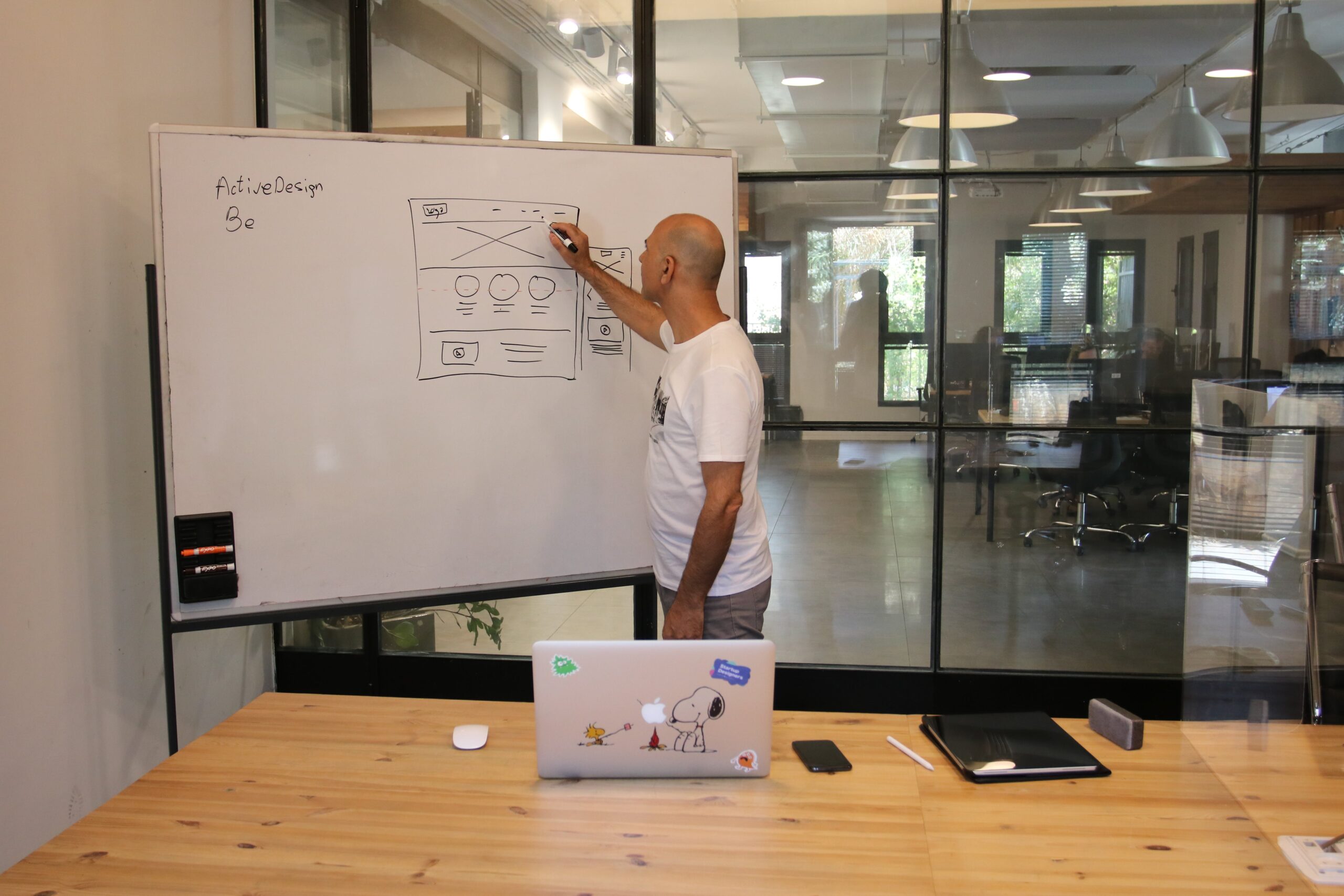Imagine using a product that seems to read your mind—it knows exactly what you need and when you need it. That’s the power of excellent user experience (UX), and it’s what we’re passionate about.
This article focuses on the crucial role of UX and product management. We aim to show how integrating UX research into product development can lead to more successful, user-friendly products.
We’ll explore the benefits of UX research in product management, including how it can improve user satisfaction, reduce development costs, and give your products a competitive edge. This guide also examines the distinct but complementary roles of UX Researchers and Product Managers and how their collaboration can optimize product development. For product managers looking to deepen their engagement with UX, we provide actionable insights on working effectively with UX research teams and utilizing user research in your product strategy.
Our goal is simple: to equip you as a product manager with the knowledge and techniques to integrate UX research into your work, resulting in products that better meet user needs and stand out in the market.
Table of Contents
Benefits of UX Research for Product Management
User research is a process used by designers, product managers, and other professionals to understand their target audience or users’ needs, behaviors, and preferences. User research aims to gather insights that can inform the design and development of products, services, or systems to meet the users’ requirements better.
UX research benefits Product Managers by enhancing user satisfaction, reducing development costs, and improving product usability. It aids in making informed, data-driven decisions and offers a competitive edge by understanding user needs. Additionally, UX research helps mitigate risk, enhances product accessibility, and guides strategic development. It also leads to increased sales and customer retention, making it a crucial component in successful product management.
User Experience (UX) research provides various benefits to Product Management. Here’s a rundown of the key advantages:
- Enhanced User Satisfaction: By understanding the needs, behaviors, and motivations of your users, you can create products that they find truly useful and enjoyable, leading to increased satisfaction and loyalty.
- Reduced Development Costs: Identifying potential issues and user needs early in the development process can help avoid costly redesigns and redevelopment after launching the product.
- Improved Usability: UX research helps make products more intuitive and easier to use, which means users can accomplish their goals efficiently, leading to better overall product performance.
- Increased Sales and Conversions: A product with a superior user experience will likely be adopted and recommended. Happy users can become your best advocates, driving sales through word-of-mouth.
- Informed Decision-making: UX research provides data-driven insights that inform product decisions, moving away from guesswork and assumptions toward what users need and want.
- Competitive Advantage: By thoroughly understanding and addressing user needs, you can differentiate your product from competitors, offering features and experiences that set you apart in the marketplace.
- Risk Mitigation: Testing and validating ideas with real users before full-scale development means less risk of product failure as you have evidence to back up your strategies and design choices.
- Enhanced Accessibility: UX research includes understanding the needs of users with disabilities and ensuring that the product is accessible to a broader audience, thereby expanding the market reach.
- Strategic Development: UX research helps prioritize features based on user needs, creating a roadmap that aligns with your users’ most pressing requirements and business goals.
- Better Retention: With a product that continues to meet user needs and provides a pleasant experience, customers are more likely to stick around, improving retention rates and reducing churn.
By incorporating UX research deeply into product management, businesses go beyond mere product design; they shape experiences that truly connect with users. This approach not only builds a devoted customer base but also propels sustainable growth, as the focus shifts from just creating products to crafting meaningful user experiences.
Understanding the benefits of UX research in product management leads us to the next important topic: the distinct roles of UX Researchers and Product Managers. While UX research provides valuable insights, the effectiveness of these insights depends on how the product team implements them. This is where the collaboration between UX Researchers, who gather and analyze user data, and Product Managers, who apply these insights to guide product strategy, becomes vital.

UX Researcher vs. Product Manager
UX Researchers and Product Managers are integral to creating successful products, but their roles in product development differ significantly in focus and responsibilities. Here’s a comparative look at the two:
UX Researcher:
Role Focus:
- A UX Researcher focuses on understanding user behaviors, needs, and motivations through observation techniques, task analysis, and other feedback methodologies.
Key Responsibilities:
- Conducting primary research, including interviews, surveys, and usability studies.
- Analyzing user feedback and behavior to understand the problems or needs.
- Creating user personas and scenarios to guide design based on user behaviors.
- Sharing insights with the product team to inform design decisions.
- Validating that product designs meet user needs and usability requirements.
- Keeping abreast of the latest trends in user experience and human behavior.
Product Manager:
Role Focus:
- A Product Manager is responsible for a product’s overall vision, strategy, and success. They act as a bridge between the business, technology teams, and users.
Key Responsibilities:
- Setting the product strategy and roadmaps based on market research and business needs.
- Prioritizing product features and backlog items based on business impact and user value.
- Working with cross-functional teams (including UX Researchers) to deliver product features.
- Defining and analyzing metrics that inform the success of products.
- Coordinating go-to-market strategies and ensuring that the product aligns with business objectives.
- Continuously balancing user needs with business requirements and technical feasibility.
Overlap and Interaction:
- Collaboration
- Goal Alignment
- Communication
Collaboration between UX Researchers and Product Managers is essential for creating user-centric and viable products. UX Researchers gather user insights, while Product Managers use these insights to guide product strategy and market positioning. Effective communication ensures these insights are integrated into product development. This partnership results in products that are functional, user-friendly, and strategically aligned with market needs.
What Type of UX Research Do Product Managers Do?
Product Managers may not typically conduct UX research to the same depth as UX Researchers. Still, they often engage in various research-related activities to inform their strategy and decision-making. Here are some types of UX research that Product Managers might be involved in:
1. Market Analysis:
Understanding the broader market context in which users operate, including trends, competitor analysis, and market demands. This helps in identifying opportunities for new products or features.
2. User Interviews:
While in-depth interviews are often left to UX Researchers, Product Managers may conduct brief interviews to get a quick read on user needs or responses to a concept.
3. Persona Development:
Product Managers might create or use personas, which are archetypal users whose goals and characteristics represent the needs of a larger group of users, to guide decision-making and prioritization.
4. Surveys and Questionnaires:
These are used to gather quantitative data from users about their preferences, behaviors, and satisfaction with current products or features.
5. Usability Testing Observation:
Product Managers may not facilitate these sessions but might observe usability testing to understand how users interact with their products.
6. A/B Testing:
This involves comparing two versions of a product or feature to see which one performs better. Product Managers often oversee A/B tests to make data-driven decisions about product changes.
7. Analytics Review:
Product Managers frequently analyze user behavior through metrics such as conversion rates, time on site, and user flows within a product to make informed decisions about product improvements.
8. Customer Feedback:
Gathering and synthesizing feedback from customer support, forums, reviews, and social media can provide qualitative data that informs UX improvements.
9. Workshops and Collaborative Sessions:
They might facilitate or participate in workshops that include empathy mapping, design sprints, or feature prioritization exercises to align the product team.

How to Collaborate with UX Research Teams as a Product Manager?
Product managers can conduct research independently, but coordinating with UX research teams is essential to avoid compartmentalized efforts. This is crucial because it prevents redundancy and inconsistency in understanding user needs. Collaborative work between Product Managers and UX research teams ensures a unified and comprehensive approach to product development, fostering innovation and enhancing the overall quality of the product. This collaborative approach streamlines efforts, maximizes resources, and guarantees that the final product is user-centric and strategically sound.
The degree to which product managers are involved in user research may differ among teams; however, the partnership with UX research should be built on joint effort, empowerment, and openness.
Here’s some advice for product managers engaging with UX research:
- Incorporate user research into your schedule.
Ensure to set explicit timelines for deliverables, whether in initial meetings or regular updates with the UX research team or when participating in user research sessions. Facilitate consistent, interdisciplinary discussions to support collaborative work.
- Arrive with a specific issue and its background.
Convey the reasoning behind the problem statement to the user research team. A product manager’s expertise lies in identifying and prioritizing critical issues. Ensure that when this problem is brought to the team’s attention, its immediacy and significance are well articulated.
- Select the appropriate research method for your schedule.
For Product Managers, selecting the proper UX research method involves balancing objectives with available time and resources. Quick feedback can be gathered through online surveys or A/B testing, while in-depth insights may require user interviews or focus groups. Collaborating with UX Researchers can help in choosing the most effective method. Planning for efficiency and being open to adjusting the approach based on initial findings are crucial. Ultimately, the preferred method should align with the project’s goals and integrate seamlessly into the broader product strategy.
- Develop a formalized briefing process for UX researchers.
When initiating a research project, it’s essential to approach the UX research team with clarity on what you require from them and what they can expect in return. This might involve creating a detailed document outlining the specifics needed to commence a research project.
- Actively engage and document during user interviews.
Instead of relying on indirect reports, being directly involved in research sessions allows product managers to gain firsthand insights and contributes an additional viewpoint that can benefit the research team.
- Ensure consistency in tools and procedures.
Select suitable collaboration tools and agree on a rhythm for meetings with UX researchers and other groups to maintain a unified approach within your organization.
- Maintain open lines of communication regarding limits and requirements.
It’s crucial for product managers, who liaise with various teams, to convey their needs clearly to the UX research team. Product managers and UX research teams communicate effectively through regular meetings and clear, detailed project briefs. Establishing feedback channels, defining objectives and metrics, and being transparent about constraints are key. Utilizing collaborative tools, involving researchers in decision-making, practicing active listening, continuous learning about UX trends, and respecting the research team’s expertise further strengthen this relationship. These strategies ensure that both teams are aligned, informed, and working towards shared goals efficiently.
- Establish and use a central insights database.
An insights repository should serve as a collective and readily available resource containing all insights about your company, product, and users, which should be accessible and contributable by all research participants, including designers, researchers, product managers, and marketers.

UX and Product Management: Tips for Planning, Conducting, and Analyzing Research
When it comes to planning, conducting, and analyzing research within the scope of product management and UX, it involves a strategic approach that’s as nuanced as it is methodical. Here’s a cohesive guide that blends these stages into a narrative suitable for product managers looking to harness the power of user-centered research:
Planning the Research Journey:
Planning is the foundation upon which all insightful research is built. Start by immersing yourself in the needs and behaviors of your target users. Understanding who you’re designing for isn’t just about demographics; it’s about getting into the mindset of your users, empathizing with their challenges, and foreseeing their needs.
Choosing the correct method is akin to selecting the best tools for a job. Whether qualitative or quantitative, each research method will illuminate different facets of user interaction with your product. This step also involves setting up a recruitment strategy to ensure that the voices you hear represent your diverse user base accurately.
At this juncture, it’s crucial to lean on resources that streamline the process—utilizing templates and guidelines for efficiency and ensuring consistency and comprehensiveness in the data you collect.
Embarking on the Research Expedition:
Conducting research is much like navigating uncharted waters. As a product manager, you must be an active listener, an observer, and an empathetic interpreter of user feedback. During interviews or usability tests, your role is to probe beneath the surface, uncovering what users say and what they mean.
Incorporating tools and technology can make this process smoother and more collaborative. Digital platforms can enable real-time note-taking, video recording, and even remote user testing, which are invaluable in today’s dispersed working environments.
Navigating the Analysis Terrain:
After the data has been gathered, patterns emerge, and insights are distilled in the analytical phase. Analyzing research is a meticulous process—the narrative of your user’s experience is woven from various data points. It’s not just about identifying trends; it’s about understanding the story behind the numbers, the user behaviors, and their interactions with your product.
Keeping an organized repository of insights is like charting a map for future reference—a map that the entire product team can use to guide their decisions. It ensures that the knowledge gained from the research is accessible and actionable, forming a knowledge base that can influence product strategy and direction.
Conclusion
In conclusion, UX research is not just a phase in the product development cycle; it is a compass that guides every decision a product manager makes. By incorporating user-centered research into product management, we can ensure that our products are functional and relevant and deliver meaningful experiences that resonate with our users. Ultimately, the message is clear: when we prioritize understanding and meeting the needs of our users, we set the stage for products that are not only successful in the marketplace but also beloved by those who use them. Let us continue to unleash the full potential of UX in product management, fostering innovation, satisfaction, and loyalty with every product we create.
Join us on the path to research excellence. Get your free Tetra account and transform your user research process.




